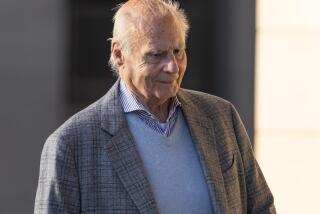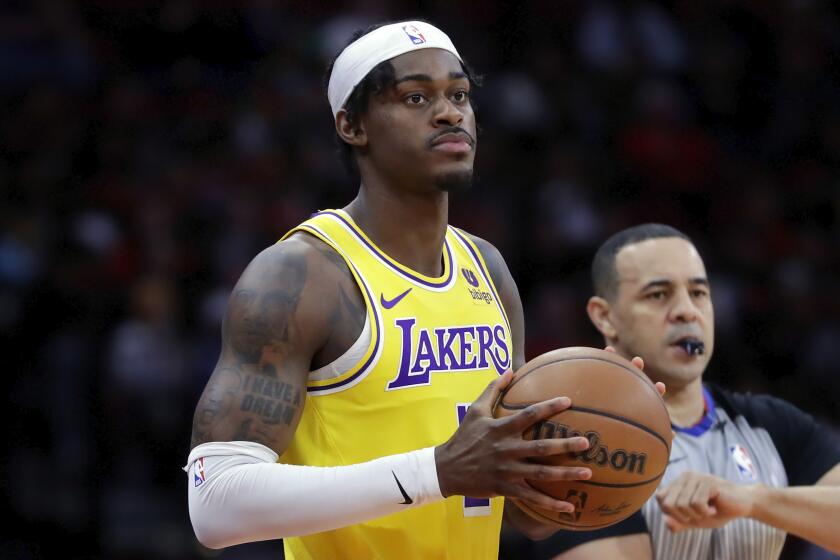It’s All Fished Out in Florida
- Share via
JUPITER, Fla. — In the spring clubhouse of the Florida Marlins, with all of the unfamiliar names above the lockers generating the impression of having wandered into the minor league complex by mistake, there is at least the surviving presence of Lenny Harris for veteran perspective, dismayed as he is.
“Like everybody else,” said Harris, who holds baseball’s career record for pinch hits, “I was shocked by what happened in the off-season. We had a contending team that was close to putting the chemistry together again and it was torn apart.
“I mean, all teams go to spring training usually with one or two guys having the opportunity to make the major league roster, but I’ve never seen it like this. I’ve never seen a situation where 23 or 24 guys are getting that opportunity at the same time.”
In a chilling winter amid the heat of South Florida, with the long unresolved issue of a new ballpark providing the impetus, a second Marlin owner chose to eviscerate the payroll and roster of a World Series winner.
Wayne Huizenga did it immediately after his October victory in 1997. By New Year’s Day he had dumped Kevin Brown, Moises Alou, Robb Nen and Devon White, among others, and a second wave followed in May, claiming Gary Sheffield and others.
Current owner Jeffrey Loria played it differently, though no less totally and devastatingly.
“We won a World Series in 2003,” club President David Samson said, “and thought we had a chance to defend in 2004 and 2005. We didn’t get it done, and the stadium didn’t get done.
“As difficult as it was, we had to make a fiscally responsible decision, and we were left with no other choice” but to gut the roster and payroll. “This is Jeffrey’s seventh season as an owner, and the first six have been fraught with enormous losses. With no firm plan going forward in Florida, there was no reason to continue losing money to that extent.”
It’s a murky business, trying to analyze baseball economics. How much money Loria and the Marlins have lost is uncertain. But he is the third owner, following Huizenga and John Henry, to wage an unsuccessful bid for a new ballpark -- the key, perhaps, to finally turning what has been an enigmatic market into a gateway franchise amid the booming Latino population and proximity to baseball’s Caribbean hotbed.
In the meantime, with the commissioner’s approval, Samson has traveled to Portland, San Antonio and Norfolk, Va., to explore relocation options while weighing other invitations.
“The possibility that we will have to relocate is more real than ever, and I don’t say that with a smile,” Samson said. “It’s simply a fact. We haven’t made the kind of progress in Florida we had hoped to make.”
When the state legislature refused to fill a $30-million gap between contributions by Loria and Miami-Dade County toward a $335-million stadium near the Orange Bowl (“We thought we had a done deal,” Samson said), and when explorations in Hialeah and other Miami-area locations went nowhere, the Marlins ultimately took an ax to the roster and payroll.
Through trade and free agency, an alphabetical list of the departed includes Josh Beckett, A.J. Burnett, Luis Castillo, Jeff Conine, Carlos Delgado -- only a year after he was signed to a four-year, $52-million contract -- Juan Encarnacion, Alex Gonzalez, Paul Lo Duca, Mike Lowell, Guillermo Mota and Juan Pierre.
The Marlins will operate with an $18.5-million payroll this season while trying to compensate for the 53 homers, 350 runs and 307 runs batted in that were traded. It is widely agreed that General Manager Larry Beinfest obtained some quality talent while cleaning house, but whether double-A potential can translate to big league success at a wholesale level is questionable.
“It’s going to be tough,” said Harris, who at 41 finds his situation uncertain despite having appeared in more big league games than any projected 25-man roster composition combined, barring acquisitions.
“Of course,” Harris added, “these kids are already underdogs. No one expects them to win 50 games. They’re going to have an opportunity to show what they’re made of.”
Aside from Miguel Cabrera at third base and Dontrelle Willis at the front of the rotation, the Marlins are conducting a spring job fair. The projected double-play combination of shortstop Hanley Ramirez and second baseman Dan Uggla appeared in two major league games last year, both by Ramirez with the Boston Red Sox. Left field and center field are a mystery, the three probable starters behind Willis -- Brian Moehler, Jason Vargas and Josh Johnson -- registered 11 big league wins last year, and the closer role will be filled by a committee of nomadic or untested applicants.
None of this, of course, fazes or dents the enthusiasm of 41-year-old rookie Manager Joe Girardi, the veteran catcher who played with the New York Yankees for four years in the late ‘90s and joined Joe Torre’s coaching staff in 2004.
In replacing the retired Jack McKeon, whose homespun magic with the 2003 World Series team eroded into something of a disappointing disconnect by 2005, Girardi was hired in October when the stadium issue was still percolating and it wasn’t certain whether the Marlins were going to load or unload.
“I was comfortable either way,” Girardi said. “They have a track record here for making good trades, and I know Jeffrey has a burning desire to win. I learned from Joe Torre that you always have to manage the hand you’re dealt, and that’s my job. It’s not my job to get a new stadium and it’s not my players’ job to get a new stadium. Eventually, we’ll have a stadium somewhere. Right now, I have a home and place to play, and that’s all I need.”
Girardi played 15 years in the big leagues and long aimed himself toward managing, surviving and staying ahead, he said, because of his affection for and attention to the major components of managing -- details, discipline, strategy and relationships. He also said that when he was coming up, he always played a classification ahead, and he’s convinced it helped him.
“I believe in these kids and don’t mind letting them learn the hard way,” he said. “Experience learned the hard way is sometimes the best experience, and everybody has to go through it. In this situation they’ll at least have each other to rely on. They won’t have to feel they’re so alone.”
With all of that, with all of the youth and roster vulnerability, Girardi said he would still place expectations on his players in a market where stadium expectations seem comatose.
The Marlins’ lease at Pro Player Stadium expires after the 2007 season but can be renewed yearly through 2010. Are any of the relocation options really viable considering most were dismissed during the relocation of the Montreal Expos? Might the commissioner’s office find a way to fill the financial gaps that are inflating with time and revitalize the stadium proposal in Miami once the Washington ownership situation is finally resolved? Will contraction resurface?
The answers are as uncertain as the Marlin lineup.
More to Read
Go beyond the scoreboard
Get the latest on L.A.'s teams in the daily Sports Report newsletter.
You may occasionally receive promotional content from the Los Angeles Times.










